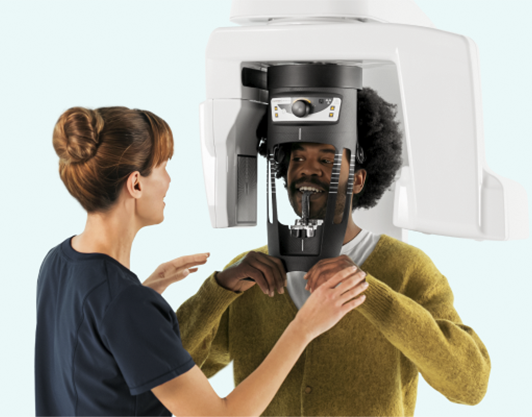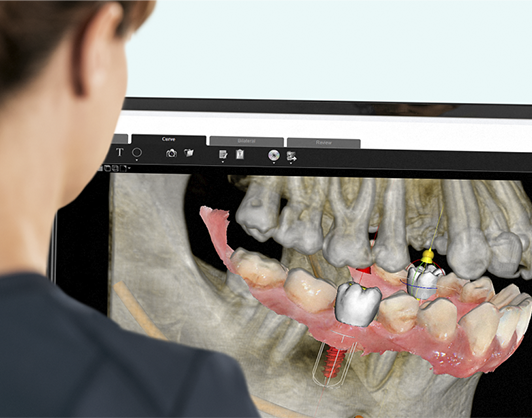 Dentistry is an inherently visual profession, requiring clinicians to blend creativity with academic expertise in order to provide optimal patient care. A comprehensive approach to imaging is essential throughout the treatment process – from initial assessment to treatment completion – to guide clinical decisions and document results. As such, a wide range of imaging modalities, from clinical photographs and digital scans to CBCT imaging, plays a critical role in diagnostics and treatment planning. A thorough understanding of why to use each solution, and when and how to elevate safety standards is crucial.
Dentistry is an inherently visual profession, requiring clinicians to blend creativity with academic expertise in order to provide optimal patient care. A comprehensive approach to imaging is essential throughout the treatment process – from initial assessment to treatment completion – to guide clinical decisions and document results. As such, a wide range of imaging modalities, from clinical photographs and digital scans to CBCT imaging, plays a critical role in diagnostics and treatment planning. A thorough understanding of why to use each solution, and when and how to elevate safety standards is crucial.
Advantages all-around
Modern dentistry would not be the same without imaging of any kind. It goes without saying that it is crucial for reliable diagnostics and therefore high-quality patient care. The digital solutions available right now have been developed to eradicate many of the challenges of conventional film-based imaging.[i] Few modern clinicians would be willing to commence endodontic or implant dentistry without first understanding where the major arteries and other vital structures are located, for example.
But imaging has a far broader application in dentistry. Pictures are also a critical tool in enhancing a patient’s understanding of their own oral health status or need for treatment. Although particularly beneficial for patients with lower literacy levels,[ii] visual aids such as clinical photographs can significantly improve dentist-patient communication. There is also evidence that pictorial health information improves patient recall.[iii]

Furthermore, clinical photography is excellent for marketing the practice and a dental professional’s work specifically to attract new business. With appropriate consent, imaging can be published online, on social media and in the professional press to appeal to potential new patients and increase referral opportunities from other clinicians.
From start to finish
Given the many advantages of effective imaging throughout the dental treatment process, it is important to seek the right data for each step. The vast majority will be required as part of the initial patient assessment to aid diagnostics, from photographs and intraoral scans to 2D radiographs and even 3D imaging where more information is needed to inform treatment planning for oral surgery, for example.
Both photographs and radiographs also serve as evidence of treatment need and completion, which are important for complete clinical records. Should an external audit be conducted, or a patient complaint submitted, the visual records will be critical in demonstrating the reasons for procedural recommendations and the outcome of each.

Indications and justifications
As is true in any area of dentistry, it is important to balance the benefits of clinical imaging with any potential risks to ensure treatment remains in the best interests of the patient. This is applicable when considering any type of radiographic or CBCT imaging, ensuring that any radiation exposure to patients is appropriate, minimised and ethical.
As such, use of related technology must be justified by identifying need for radiographic visualisation of the patient’s anatomy. A summary of the criteria for dental radiology is available from various sources, including a guidance document published by the College of general Dentistry.[iv]
Patient radiation exposure can be reduced by applying the ALARA (A Low As Reasonably Achievable) principle and by selecting the smallest field of view necessary for the issue at hand. It is also important to optimise any image capture to lower the risk of requiring repeat images. This will include correct patient positioning and metal artifact management to ensure images produced are accurate, clear and useable. To ensure competence and confidence in all these areas, it is important that clinicians prescribing and/or interpreting CBCTs have undergone the relevant training.[v]
Consideration must also be given to how any image data is captured, shared and stored. In today’s digital world, this involves maintaining a high standard of cyber security so that digital imaging remains safe.
Optimising the imagery
Clinical imaging is a powerful tool in the delivery of first-class patient care – no matter what type of dentistry being provided. For excellent artefact-free image clarity, increased fields of view for maximum flexibility and safety, versatile application and ease of use, choose the innovative CS 8200 3D Advance Edition from Carestream Dental. It is a four-in-one imaging solution, featuring open integration for simple implementation. Being scalable, it can also adapt to meet the evolving needs of the practice, with new AI functionality coming to market later this year.
In dentistry, a picture really does say a thousand words. Make sure you’re capturing the right pictures for excellent patient care every time.

For more information on Carestream Dental visit www.carestreamdental.co.uk
For the latest news and updates, follow us on Facebook and Instagram @carestreamdental.uk
Nimisha Nariapara is the Trade Marketing Manager at Carestream Dental covering the UK, Middle East, Nordics, South Africa, Russia and CIS regions. She has worked at Carestream Dental for the past 7 years, where she has developed her marketing skills and industry knowledge to bring the core values and philosophy of the company to the market.
[i] van der Stelt PF. Better imaging: the advantages of digital radiography. J Am Dent Assoc. 2008 Jun;139 Suppl:7S-13S. doi: 10.14219/jada.archive.2008.0357. PMID: 18539866.
[ii] Houts PS, Doak CC, Doak LG, Loscalzo MJ. The role of pictures in improving health communication: a review of research on attention, comprehension, recall, and adherence. Patient Educ Couns. 2006 May;61(2):173-90. doi: 10.1016/j.pec.2005.05.004. Epub 2005 Aug 24. Erratum in: Patient Educ Couns. 2006 Dec;64(1-3):393-4. PMID: 16122896.
[iii] Schubbe D, Scalia P, Yen RW, Saunders CH, Cohen S, Elwyn G, van den Muijsenbergh M, Durand MA. Using pictures to convey health information: A systematic review and meta-analysis of the effects on patient and consumer health behaviors and outcomes. Patient education and conseling. October 2020; 103(10); 1935-1960
[iv] College of General Dentistry. Selection criteria for dental radiography. https://cgdent.uk/selection-criteria-for-dental-radiography/ [Accessed April 2025]
[v] NHS. Newcastle Hospitals Skills Academy. Dental CBCT Levels 1 & 2 https://skillsacademy.newcastle-hospitals.nhs.uk/course/dental-cbct-level-1s-2-combined-course-march-2024/#:~:text=A%20dentist%20referring%20for%20CBCT,HPA%2DCRCE%2D010%20report. [Accessed April 2025]
















